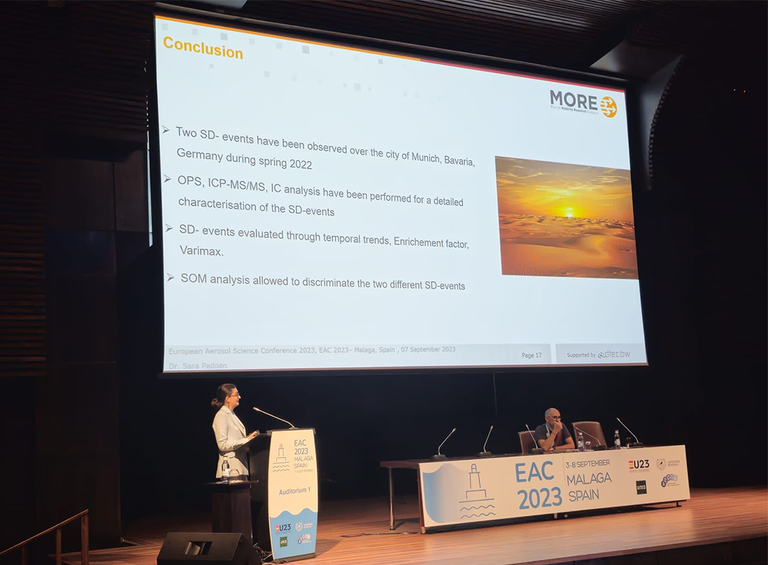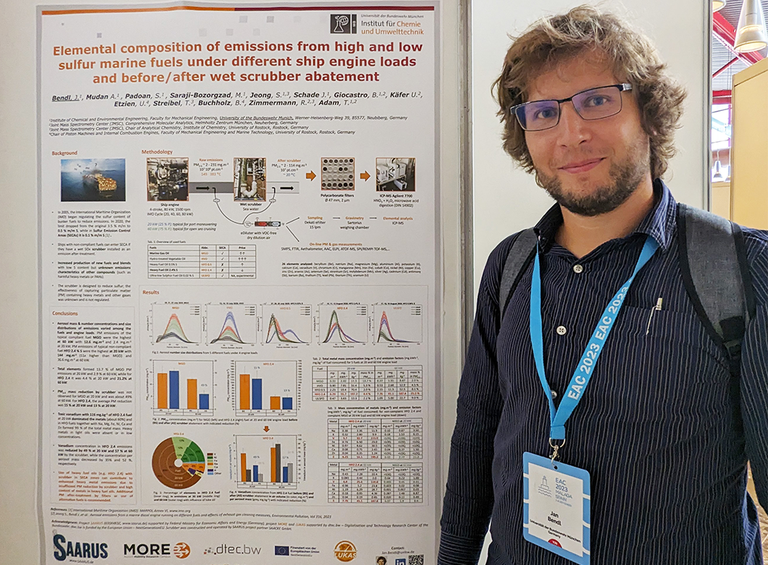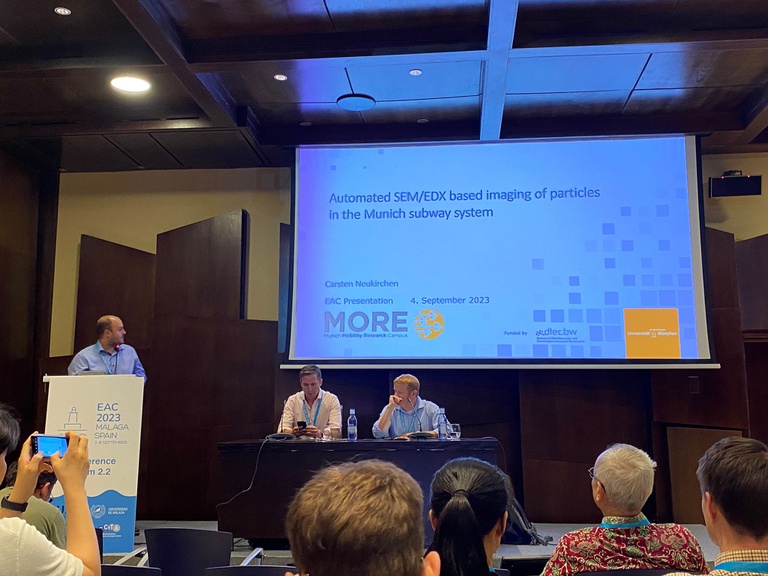European Aerosol Conference (EAC) 2023 in Malaga
At the European Aerosol Conference (EAC) from 3. to 8. of September 2023 in Malaga, Prof. Thomas Adam and members of his research group presented the latest results of their studies, mainly focused on ambient air quality and emission measurements.
|
In her presentation entitled „PM2.5 metallic and ionic composition during Saharan dust events over Munich”, Dr. Sara Padoan presented the significant results of a study conducted on the chemical characterization of the Particulate Matter (PM) during several Saharan dust (SD) events that crossed the city of Munich in 2022, within the MORE project. She mostly focused on the characterisation of the metallic and ionic fractions on PM2.5 samples daily collected inside the UniBw-M campus. The elemental fraction was evaluated by the analytical technique of Inductively Coupled Plasma Mass Spectrometry (ICP-MS/MS), while the ionic fraction was evaluated by Ion Chromatography (IC). The dataset was treated with advanced chemometric techniques, such as Varimax analysis and Self-Organising Maps (SOM) which allowed to group daily observations in order to find patterns of samples and variables. The results have shown a general increase in PM and chemical compounds concentrations during the two SD events. In addition, it was also possible to identify some differences in the chemical composition of the two events due to a different aerosol enrichment, related to their different paths. SOM well discriminated the SD events from the normal urban pollution of Munich, indicating the enrichment of some elements due to the presence of Sahara dust.
|

|
 |
In his presentation entitled "Spatio-temporal dynamics and characterization of subway PM using a self-made mobile system", Jan Bendl presented new findings regarding the unique mobile measurement of air quality in Munich's subway during ordinary commutes within the dtec.bw MORE and LUKAS projects. He focused mainly on the high dynamics of the aerosol and its spatio-temporal variability, with the highest concentrations at large transfer stations. No significant differences in particulate matter levels were observed when travelling on new or old trains, so possible mitigation measures, such as the use of filters in air conditioning units and the driver's cab, were suggested.
|
|
In his contribution entitled "Elemental composition of emissions from six high and low sulphur marine fuels under different ship engine loads and before/after wet scrubber abatement", Jan Bendl drew attention to the issue of ship emissions in the light of new international regulations, where ships using non-compliant heavy fuel oils have exception to enter low-emission SECA zones with the use of a special sulphur scrubber to wash out sulphur. However, in extensive experimental emission measurements within the SAARUS project we have found that toxic elements such as Vanadium bound to aerosol are not scrubbed effectively as sulphur and thus it’s high concentrations in the air pose a health risk, especially to residents of port cities.
|
 |
 |
In his presentation entitled "Automated SEM/EDX based imaging of particles in the Munich subway system", Carsten Neukirchen presented an automated approach for obtaining single particle elemental spectra and morphological data via SEM/EDX in the example of aerosol from the Munich subway system. The obtained data was automatically compared to pre-defined rulesets and classes of emission sources were assigned by the algorithm. Over 90% of all particles were classified as iron oxides, originating from abrasion processess at the wheel-rail-brake interface of trains, highlighting the highly ferruginous nature of subway aerosols.
|
The EAC is one of the largest conferences in the field of aerosols and air quality measurement. It was attended by leading experts not only from Europe, but from all over the world, and was thus a perfect opportunity to gain the latest knowledge and establish contacts for possible future cooperation.



